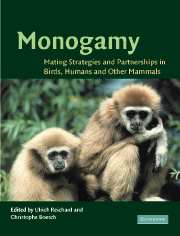CHAPTER 1 - Monogamy: past and present
Published online by Cambridge University Press: 05 July 2014
Summary
MONOGAMY APPROACHED
Scientists have been interested in social monogamy in animals for a long time (Wickler & Seibt, 1983; Dewsbury, 1988). By the end of the Victorian era, animal monogamy was already intuitively fascinating perhaps because it seemed to mirror most closely the living ideal of Western, industrialized societies: human monogamy as reflected in an early description of social monogamy as ‘animal marriage’ (Wundt, 1894). Part of social monogamy's attractiveness probably stemmed from both the assumed and postulated mutual faithfulness of the individuals in these partnerships. Unfortunately, social monogamy, which primarily describes a demographic and close sociospatial relationship between one male and one female, has often been mixed both with exclusive mating as well as joint reproduction and biparental care of offspring. This historical conflation has resulted in misunderstandings and disagreement about the biological meaning of the ‘monogamy phenomenon’ as well as conflicting expectations and interpretations among scientists about selective forces and behavioural traits associated with it (e.g. Wickler & Seibt, 1983; Murray, 1984; Mock, 1985; Dewsbury, 1988; Mock & Fujioka, 1990; Gubernick, 1994).
Variation in duration and levels of monogamous partnerships
The definition of social monogamy is that a female and a male each have only a single partner of the opposite sex at a time (Black, 1996; Gowaty, 1996a). The temporal component is important for understanding socially monogamous partnerships because only few sexually reproducing organisms truly establish a unique, holistic, monogamous lifetime partnership in which partnership duration equals the partners’ remaining lifespan (i.e., Southgate et al., 1998).
- Type
- Chapter
- Information
- MonogamyMating Strategies and Partnerships in Birds, Humans and Other Mammals, pp. 3 - 26Publisher: Cambridge University PressPrint publication year: 2003
- 55
- Cited by



